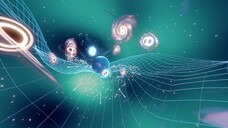The very high-energy particle of light that reached Earth on October 9 with the most powerful gamma-ray burst ever observed may hold clues to the mysterious dark matter, according to a study by Italian researchers from the National Institute of Astrophysics and the National Institute of Nuclear Physics published in Physical Review Letters.
Current theories hold that that particle of light (photon) should never have arrived on Earth.
To explain the phenomenon, the Italian researchers offer an interpretation according to which it was transformed into a hypothetical particle called ALP (axion-like particle), predicted by string theory.
The event in which it was observed is the gamma-ray burst GRB 221009A, emitted by a galaxy more than two billion light years away.
Among the photons that accompanied it, observed by the Chinese Lhaaso detector, one had an energy of 18 TeV, the highest ever recorded from a gamma-ray burst.
“Within minutes of learning of the explosion, we realised that this gamma-ray burst could not only be an extraordinary astrophysical event, but also represent a unique opportunity for fundamental physics research,” said the first author of the paper, Giorgio Galanti of INAF.
The other authors are Lara Nava, Marco Roncadelli, Fabrizio Tavecchio and Giacomo Bonnoli.
The researchers say the photon could be a 'transformer', i.e. a particle capable of changing its nature as it travels at the speed of light, becoming an ALP or an axion, both candidates for constituting dark matter.
Riproduzione riservata © Copyright ANSA













